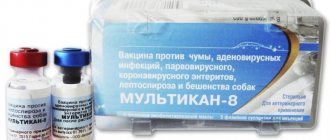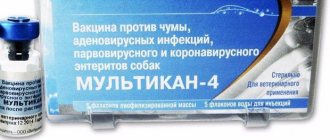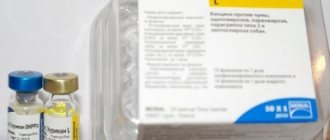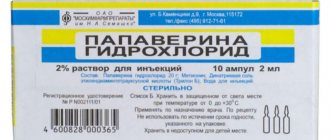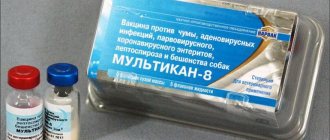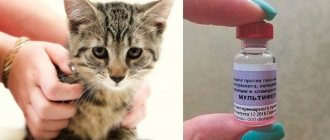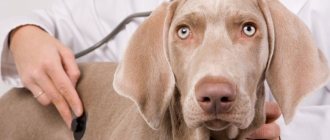- VetConsultPlus
- Informational portal
- Veterinary drug
- Name - Nobivak DHPPi
- Product type - Live vaccine against major canine pathogens
- Spectrum of diseases: parvovirus enteritis, plague, adenovirus, parainfluenza
- Course: primary vaccination 2-3 times with an interval of 21-28 days, then annually
- Features of the biological product: Live, attenuated
Nobivac DHPPi is a live attenuated vaccine for the immunization of dogs against canine distemper virus, canine adenovirus, canine parvovirus and canine parainfluenza virus.
Product information Nobivac for veterinarians - vaccine for dogs Nobivac DHPPi
Nobivac DHPPi is used for active immunization of dogs against canine distemper, canine hepatitis, dog parvovirus with a minimum duration of immunity, according to the instructions for use from the manufacturer, three years, and parainfluenza virus in dogs with immunity lasting one year. However, the company recommends that during the first year, annual vaccinations be administered as a “full” vaccination against the canine pathogens DHPPi and Lepto.
Nobivac DHPPi contains live attenuated, lyophilized canine distemper virus, canine adenovirus-2 (CAV2), canine parvovirus and canine parainfluenza virus. The vaccine contains attenuated antigens to stimulate active immunity in dogs against canine distemper virus, canine parvovirus, infectious canine hepatitis caused by canine adenovirus 1, and respiratory diseases caused by canine adenovirus type 2 and canine parainfluenza virus.
For use, dosage, contraindications and warnings, please refer to the product insert. Additional information available upon request. Use medications responsibly.
Nobivac DHPPI
This is a complex vaccine intended for vaccination and revaccination of dogs . It reliably protects your pet and contains inactive strains of canine distemper, infectious hepatitis, parainfluenza and parvovirus enteritis. Presented in the form of two ampoules: one of them contains a white or pinkish powder, and the second contains diluent (solvent).
The drug is used only for healthy animals and is safe for pregnant and postpartum females. The first vaccination is given at 8-9 weeks (from birth). Revaccination is carried out after 14 days . Subsequent repetitions depend on the breed and size of the pet. It is considered correct to vaccinate again at 6 and 12 months , and then annually . The average cost for one dose is 150 rubles ; together with the services of a veterinary clinic, vaccination will cost 400-500 rubles .
In order not to traumatize the pet’s psyche several times, Lepto against leptospirosis is administered along with this vaccine.
Learn about essential drugs in animals
- Use of Dirofen in cats
- Instructions for using Vetom in cats
- Instructions for using multifel in cats
- Instructions for use of fosprenil in cats
- Instructions for the use of Kotervin in cats. The breadth of the anti-inflammatory, saluretic effect of Cotervin for the complex treatment of many pathologies in cats
- Instructions for use Kot Bayun in cats
- Instructions for the use of feliferon in cats
- Stronghold in cats
- Instructions for use of Milbemax in cats
- Provides information about the drug gamavit
- Instructions for the use of spirovet in animals. Calculate the optimal dose of the drug in dogs, cats, pigs, cows, sheep, goats
- Instructions for the use of tiamulin in birds and animals
- Instructions for use of Sevaxel in animals
- Instructions for use of thiam-oxy in animals
- Instructions for the use of tetravet in animals
- Instructions for use of TAF 25% in chickens, turkeys and other animals
- Instructions for use of cefkinome in animals
- Instructions for the use of intramycin in animals
- Instructions for the use of inotil in animals. Calculate the optimal dose of the drug in dogs, cats, pigs, cows, sheep, goats
- Instructions for use of cobactan in dogs
- Instructions for the use of coliside in animals. Calculate the optimal dose of the drug in birds, pigs, cows, sheep, goats
- Instructions for the use of Marbox in animals. Calculate the optimal dose of the drug in dogs, cats, pigs, cows, sheep, goats
- Instructions for the use of inosel in animals. Calculate the optimal dose of the drug in dogs
- Instructions for the use of oxytetra in animals
^Top
Vaccination schedule with Nobivak
A specific regimen can be prescribed individually depending on the breed and size of the dog. The ideal option would be to vaccinate with several types of Nobivak vaccine as the puppy grows older. For the first year, a similar plan would be suitable:
- Puppy DP vaccination at 1.5-2 months (subcutaneous);
- Inoculate DHP and L4 together at 8 weeks (subcutaneous);
- At 3-6 months you need to repeat the vaccination and add a strain of rabies, Nobivak DHPPI and RL are suitable;
- The last vaccination is repeated annually; in favorable conditions, revaccination is allowed once every 2 years.
This scheme is an example of a grafting option. You can choose other Nobivak vaccines or products from another company; it is important that the puppy receives protection from all dangerous diseases.
Composition and pharmacological properties
Depending on the type of drug, the content of vaccine strains will be different. For the most part, the solutions are similar, but have detailed properties. Nobivak DHPPI is considered the most complex; using its example, you can consider the common components of all mixtures:
- Plague strain (4.0 LH);
- Adenovirus strain (4.0 LH);
- Parvovirus strain (7.0 LH);
- Parainfluenza strain (5.5 LH).
The solvent contains water for injection, phosphate buffer solution.
Similar inactive strains contain other vaccines, to which a strain of rabies and leptospirosis can be added.
Effect of the drug
Like all vaccines, Nobivak drugs are based on the work of inactive strains (samples of viral bodies), which are introduced into the animal’s body, but do not have sufficient strength to attack it. At this time, the dog's immune system studies microorganisms and “learns” to resist them. Thus, after infection with a live virus, antibodies will be able to protect the dog’s organ systems.
Depending on the type of vaccination, the duration of protection is 12-36 months. The drug begins to work within 12-15 days, this time is called quarantine.
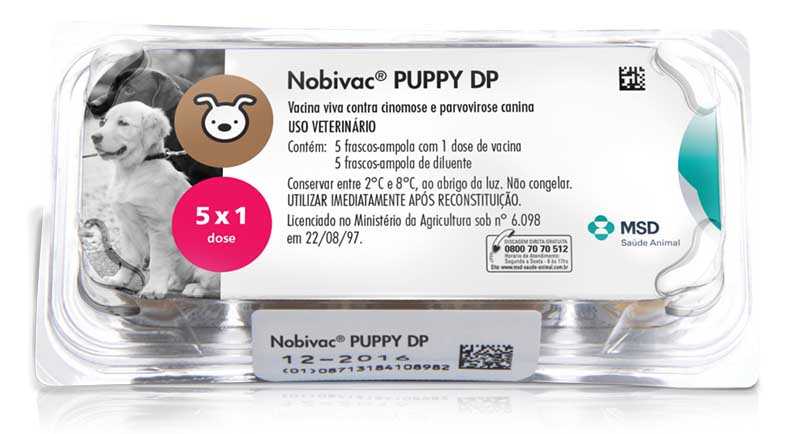
Indications for use
Indications for the use of specific types of vaccines depend on their functional effects. The full range of vaccinations is carried out for preventive purposes, and not after infection. The manufacturer assures that its products will reliably protect pets from dangerous viral diseases.
- Rabies is the most dangerous and intractable disease that destroys the dog’s central nervous system. It is also dangerous for humans. An animal can become infected from wild animals after a bite or through close contact with other domestic animals. The route of transmission is from saliva to blood. Characteristic symptoms are photophobia, convulsions, and severe drooling.
- Parvovirus enteritis is a viral disease that destroys the intestines and, in some cases, the heart of an animal. Transmitted through the feces of infected animals. Causes severe acute poisoning, diarrhea, vomiting, and a cadaverous odor. If the cells of the cardiovascular system are destroyed, the pet breathes heavily.
- Infectious hepatitis or adenoviral enteritis affects the liver, intestines, lungs, stomach, and nervous system. Caused by a blood-borne virus. Vivid signs are anemia, yellowing of the whites of the eyes and mucous membranes, fever, convulsions.
- Carnivore distemper is not dangerous to humans, but is fatal to pets in the absence of high-quality, quick treatment. Symptoms directly depend on the affected area. An obvious virus is keratinization of the skin and scabs on the surface of the epidermis.
- Parainfluenza is an insidious disease; the virus targets the lungs, then the gastrointestinal system and blood vessels. Manifests itself in the form of severe nasal discharge, coughing, sneezing, shortness of breath, anemia, and thirst.
- Leptospirosis is a bacterial disease that affects the kidneys, liver and circulatory system. In severe cases, it kills the internal microflora of the stomach, gastrointestinal tract, and nervous system.
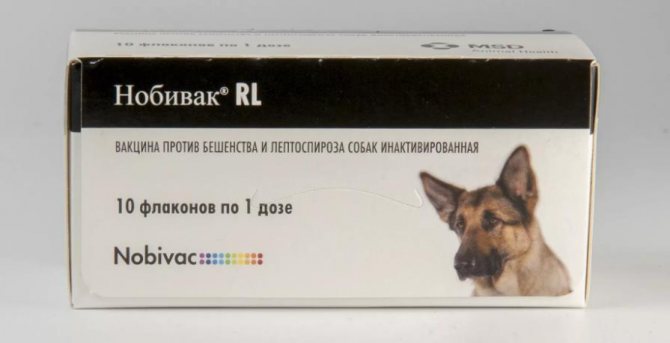
Contraindications and side effects
For this vaccine, the list of contraindications is standard. Puppies under 2 weeks of age , sick and weakened pets, and dogs sensitive to the components of the drug are not allowed to be vaccinated. Nobivak is allowed even for pregnant and lactating females, but only after consultation with a veterinarian.
The vaccine is considered safe, but short-acting side effects may occur:
- Apathy, lack of appetite;
- Nausea;
- Shiver;
- A small bump at the injection site.
During the first few hours, you need to carefully monitor your pet. If you experience convulsions, severe fever, diarrhea, vomiting, or irritation at the puncture site, you should contact the clinic. Otherwise, deadly symptoms may occur: hives in the nose, swelling of the muzzle, sneezing and breathing problems, increased salivation, and tearing.
Vaccination of adult dogs and puppies
In this material we want to tell pet owners about the rules and the need to vaccinate dogs and puppies , or simply about vaccinating dogs and puppies.
Dog vaccination should be considered one of the most important procedures for the prevention and protection against infectious diseases. As a pet owner, it is imperative to remember this preventative measure and vaccinate your dog annually. Agree that it is better to visit a veterinarian once a year and get vaccinated than to risk the health of your furry pet, and in the worst case, carry out the necessary treatment if he suddenly gets sick. If you have a busy schedule and find it difficult to find a time to visit a veterinary hospital, you can call a veterinarian at home by calling: +7.
Vaccination or inoculation of dogs and puppies is carried out with modern imported polyvalent vaccines. Veterinarians at our veterinary clinic “LiM” use vaccines from different manufacturers, but exclusively imported ones. When vaccinating puppies and adult dogs, these vaccines provide effective protection against infectious diseases and are well tolerated by animals.
To vaccinate an adult dog or puppy, we use both standard and individual vaccination regimens. Individual schemes may be required in cases where it is unknown whether the animal has been vaccinated previously, or the puppy’s vaccination period has already been missed for one reason or another, etc.
We remind you that vaccination can only be given to healthy dogs and puppies that were treated against helminths 10 days before vaccination. Simply put, 10 days before vaccination, you need to drive away worms from the dog by giving an anthelmintic drug, for example: Prazicide, Prazitel, Drontal, Dironet, Milbemax, etc.
Below, we suggest that you familiarize yourself with a number of vaccination options for dogs and puppies that we use in our practice. Let us note once again that we work only with trusted manufacturers who are known in the veterinary drug market and produce exclusively high-quality vaccines for dogs, and also have quality control, which guarantees the quality and effectiveness of the drug.
Types of vaccines for dogs:
Nobivac (Nobivak) DHPPI+L and DHPPI+LR Produced by Intervet (Netherlands).
This is an associated live vaccine that contains components against canine distemper virus, adenovirus, parvovirus, parainfluenza, leptospirosis and rabies.
Recommended Nobivak vaccination regimen: 7-8 weeks – Nobivak DHPPI + L (1 dose subcutaneously). 12-13 weeks – Nobivak DHPPI + L + R (1 dose subcutaneously). After 12 months – Nobivak DHPPI + L + R (1 dose subcutaneously).
Then once a year for the entire life of the dog. This type of vaccine is approved for use for vaccinating pregnant bitches.
Eurican (Eurikan) DHPPI2 +L and DHPPI2 +LR Produced by Merial (France).
This vaccine contains attenuated strains of canine distemper viruses, adenovirus, parvovirus, parainfluenza, inactivated leptospira and inactivated rabies virus.
Recommended vaccination schedule for Eurican: 7-8 weeks – Eurican DHPPI2 + L (1 dose subcutaneously). 12-13 weeks – Eurican DHPPI2 + LR (1 dose subcutaneously). 12 months – Eurikan DHPPI2 + LR (1 dose subcutaneously). Then once a year for the entire life of the dog.
This type of vaccine is approved for use for vaccination of pregnant bitches in the first third of pregnancy.
Hexadog (Geksadog) Produced by Merial (France).
This vaccine contains attenuated strains of canine distemper virus, adenovirus, parvovirus, inactivated leptospira and inactivated rabies virus.
Recommended Hexadog vaccination regimen: 7-8 weeks – Trivirovax or Eurican DHPPI2 + L (1 dose subcutaneously). 12-13 weeks – Hexadog (1 dose subcutaneously). 12 months – Hexadog (1 dose subcutaneously).
Then once a year for the entire life of the dog. This type of vaccine is approved for use for vaccinating pregnant bitches.
Duramune (Duramun) Manufactured by Fort Dodge (USA).
There are two varieties of this vaccine: Duramun Max 5/4L and Duramun Max 5-CvK/4L.
Vaccination Duramun Max 5/4L contains strains against plague, parvovirus enteritis, hepatitis, adenovirus, parainfluenza, leptospirosis of 4 types.
The Duramun Max 5-CvK/4L vaccine contains strains against plague, parvovirus enteritis, hepatitis, adenovirus, parainfluenza, 4 types of leptospirosis and coronavirus.
Recommended Duramun vaccination schedule: 6-7 weeks – Duramun Max 5-CvK/4L or 5/4L (1 dose subcutaneously). 8-9 weeks – Duramun Max 5-CvK/4L or 5/4L (1 dose subcutaneously). 12 weeks – Duramun Max 5-CvK/4L or 5/4L (1 dose subcutaneously) + rabies vaccine.
Then once a year for the entire life of the dog. This type of vaccine is approved for use for vaccinating pregnant bitches.
Vanguard (Vangard) 5 and 7 Manufactured by Zoetis (USA).
This vaccine contains live attenuated strains of canine distemper virus, adenoviruses, parainfluenza, parvovirus, and inactivated cultures of Leptospira.
Recommended Vangard vaccination regimen:
6 weeks – Vanguard 5 or 7 (1 dose subcutaneously). 9-10 weeks – Vanguard 5 or 7 (1 dose subcutaneously). 12 weeks – Vanguard 5 or 7 (1 dose subcutaneously) + Defensor-3 (anti-rabies component).
Then once a year for the entire life of the dog. This type of vaccine is not recommended for vaccinating pregnant bitches.
Nobivac (Nobivak) KS Produced by Intervet (Netherlands).
This vaccine contains purified attenuated pathogens of bordetellosis and parainfluenza; it is used to prevent the so-called kennel cough in dogs.
Recommended vaccination regimen Nobivak KS:
From 2 weeks of age - Nobivak KS (1 dose intranasally). Then once a year for the entire life of the dog.
Nobivac (Nobivak) Piro Manufactured by Intervet (Netherlands).
This is a bivalent vaccine against blood parasitic diseases caused by Babesia canis and Babesia rossi.
Recommended vaccination regimen Nobivak Piro:
6 months – Nobivac Piro (1 dose subcutaneously). After 3-6 weeks. – Nobivac Piro (1 dose subcutaneously).
Then every 6 months – Nobivac Piro (1 dose subcutaneously).
This type of vaccine cannot be used on pregnant or lactating bitches.
Vaccines for dogs that are not widely available and rarely used.
If you need a vaccine to vaccinate your dog, which is not on the list above, and which is not often used in veterinary practice, you can contact our VetChance veterinary office regarding this issue. We can order the necessary vaccine specifically for you and vaccinate your dog or puppy according to an individual scheme.
We would like to note that there are a number of vaccines that we do not work with on principle; the reason for this is either their low effectiveness or a high risk of side effects, the risk of which exceeds the expected benefit of vaccination.
Taking a dog abroad.
After vaccination, an international veterinary passport is issued for the dog, which contains all the marks on the vaccinations performed. If you are going to travel abroad with your dog, then you need to issue a certificate or certificate of Form No. 1 for the export of the animal, such a certificate is valid for 5 days from the date of issue and is issued only by state veterinary hospitals. It is worth knowing that if you are going to travel to EU countries, then in addition to all the necessary vaccinations, the dog must be microchipped. Most European countries require an electronic chip on an animal upon entry into the country.
Vaccinations for the prevention and treatment of trichophytosis and microsporia in dogs.
In our veterinary clinic you can also vaccinate your dog to prevent and treat trichophytosis and microsporia (lichen). We use therapeutic and prophylactic vaccines - Microderm and Vakderm.
We are always glad to see you at our veterinary clinic "LiM" for routine vaccination of a dog or puppy. If your pet does not tolerate the journey very well or you have a very busy schedule and it is difficult for you to choose a time to visit the veterinary clinic, you can call a veterinarian at home by phone or contact us through the feedback form. If you have a cat or kitten in addition to a dog, then you can find detailed information about vaccinations for cats on the page about vaccinations for cats and kittens.
